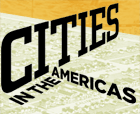Part II: Settlement, Expansion, and the Business
of City Views
New England Cities
42
View of the City of Hartford
Robert Havell, Jr. (American, b. England, 1793–1878), after his own
design
Color etching and aquatint, printed by William Neale (American, 19th century),
published by Robert Havell, Jr., 1841
Deák 508
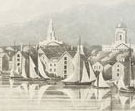 John
James Audubon’s watercolors for The Birds of America were painstakingly
etched by Robert Havell, Jr., in 433 life-sized, hand-colored aquatints. After
completing this magnum opus in 1838, Havell moved to the United States and
settled in Ossining, New York. He focused primarily on landscape painting,
but produced a few aquatints of city scenes after his own paintings, following
in the tradition and high standards of fellow English transplants John Hill
and William James Bennett.
John
James Audubon’s watercolors for The Birds of America were painstakingly
etched by Robert Havell, Jr., in 433 life-sized, hand-colored aquatints. After
completing this magnum opus in 1838, Havell moved to the United States and
settled in Ossining, New York. He focused primarily on landscape painting,
but produced a few aquatints of city scenes after his own paintings, following
in the tradition and high standards of fellow English transplants John Hill
and William James Bennett.
43
View of Salem, Mass.; View of Lynn, Mass.; View of Beverly, Mass.; View
of Danvers, Mass.
Edwin Whitefield (American, b. England, 1816–1892)
Tinted lithograph, printed by W. Endicott & Co. (New York lithographic
firm, 1849–52), ca. 1850
Deák 616
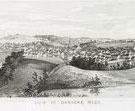 Edwin
Whitefield was a pioneer in the making and marketing of lithographic city
views. He was the first to continually travel around the United States in
search of new cities to represent, ushering in the tradition of the itinerant
lithographer. Enlisting the help of local editors, he solicited favorable
newspaper reviews of his preliminary drawings to ensure him the subscriptions
he needed to successfully publish his prints. This strategy ultimately became
common practice for artists.
Edwin
Whitefield was a pioneer in the making and marketing of lithographic city
views. He was the first to continually travel around the United States in
search of new cities to represent, ushering in the tradition of the itinerant
lithographer. Enlisting the help of local editors, he solicited favorable
newspaper reviews of his preliminary drawings to ensure him the subscriptions
he needed to successfully publish his prints. This strategy ultimately became
common practice for artists.
The Print Collection owns one of Whitefield’s sketchbooks, which includes
drawings for this lithograph of four Massachusetts cities, including both
individual details and compositional sketches. Most of Whitefield’s
early views followed the traditional format, picturing the city from a slight
elevation, although he would later adopt the popular bird’s-eye-view
format. According to the inscription, he based the view of Lynn on a daguerreotype.
Virtually from the moment of its invention in 1839, photography was both competition
for the view-making industry, and a useful tool for artists producing views.
44
View of Newburyport, (from Salisbury)
Fitz Hugh Lane (American, 1804–1865), after Alban Jasper Conant (American,
1821–1915)
Tinted lithograph with hand-coloring, printed by Lane and Scott’s Lithography
(Boston lithographic firm, ca. 1840–47), published by Alban Jasper Conant,
1846
Deák 546
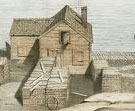 Fitz
Hugh Lane divided his career between painting and printmaking, primarily picturing
the areas surrounding Boston and Gloucester, his birthplace. In the 1830s,
he apprenticed at William S. Pendleton’s lithography shop, and with
a fellow apprentice, John W. A. Scott, opened his own firm in 1844. Around
this time he also began painting, soon discovering his love for marine life
and coastal landscapes. This view of Newburyport combines both facets of his
career. Lane collaborated with Alban Jasper Conant, a marine artist from Vermont,
on at least three other lithographs, part of the scarce number of views issued
by Lane and Scott.
Fitz
Hugh Lane divided his career between painting and printmaking, primarily picturing
the areas surrounding Boston and Gloucester, his birthplace. In the 1830s,
he apprenticed at William S. Pendleton’s lithography shop, and with
a fellow apprentice, John W. A. Scott, opened his own firm in 1844. Around
this time he also began painting, soon discovering his love for marine life
and coastal landscapes. This view of Newburyport combines both facets of his
career. Lane collaborated with Alban Jasper Conant, a marine artist from Vermont,
on at least three other lithographs, part of the scarce number of views issued
by Lane and Scott.
45
Provincetown, from Long Point
After a photograph by George H. Nickerson (American, 1835–1890)
Tinted lithograph, published by F. K. Rogers, 1877
Deák 852
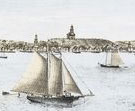 When
the Mayflower landed on Cape Cod in 1620, the pilgrims emerged on
land that later became Provincetown. Sustained in its early years by whaling
interests, the city later became a haven for artists, writers, and actors.
When
the Mayflower landed on Cape Cod in 1620, the pilgrims emerged on
land that later became Provincetown. Sustained in its early years by whaling
interests, the city later became a haven for artists, writers, and actors.
Although photography eventually supplanted lithography as a more accurate
and less labor-intensive means of reproduction, it was often used as the basis
for lithographic views. George Hathaway Nickerson was born in Barnstable,
Massachusetts, and was active in Provincetown from 1870 to 1890 making stereographs,
a type of photography which produces two nearly identical images that when
viewed through a special apparatus, a stereoscope, appear three-dimensional.
46
Portland, Me.
Charles Parsons (American, b. England, 1821–1910), after John William
Hill (American, b. England, 1812–1879)
Lithograph, printed by Endicott & Co. (New York lithographic firm, 1852–86),
published by Smith Bros. & Co., 1855
Deák 702
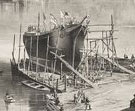 Portland,
Maine, is the setting against which this lively port scene, populated by over
200 figures, unfolds. It was rendered by John William Hill, son of the prominent
printmaker John Hill. The younger Hill spent his early years producing city
views, until, in Portland in 1855, he encountered the writings of John Ruskin,
which significantly altered the course of his work by turning him to the countryside
for inspiration.
Portland,
Maine, is the setting against which this lively port scene, populated by over
200 figures, unfolds. It was rendered by John William Hill, son of the prominent
printmaker John Hill. The younger Hill spent his early years producing city
views, until, in Portland in 1855, he encountered the writings of John Ruskin,
which significantly altered the course of his work by turning him to the countryside
for inspiration.
Charles Parsons, working in conjunction with the printers Endicott &
Company and the publisher the Smith Brothers, lithographed several of Hill’s
views of North American cities. Parsons went on to have a prolific career
with Currier & Ives, producing many of their New York City views.
47
A View of Portsmouth in New Hampshire, Taken from the East Shore
Colored etching, from The Atlantic Neptune, published by Joseph F. W. Des
Barres, 1778
Deák 162
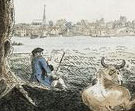 Portsmouth,
the only seaport in New Hampshire, was included in the first great series
of nautical views of the New World, The Atlantic Neptune. Although
the charts in the series were notably precise in conveying practical knowledge
of the coastline, the charts and views also include picturesque touches, such
as this foreground scene of two recumbent cows and an artist sketching. They
are much more than purely practical, giving glimpses into the urban settings
of Revolutionary-era America.
Portsmouth,
the only seaport in New Hampshire, was included in the first great series
of nautical views of the New World, The Atlantic Neptune. Although
the charts in the series were notably precise in conveying practical knowledge
of the coastline, the charts and views also include picturesque touches, such
as this foreground scene of two recumbent cows and an artist sketching. They
are much more than purely practical, giving glimpses into the urban settings
of Revolutionary-era America.
Note to the checklist. “Deák” refers
to the catalogue of American historical prints in the New York Public Library’s
collections: Deák, Gloria Gilda. Picturing America 1497-1899. Prints,
Maps, and Drawings bearing on the New World Discoveries and on the Development
of the Territory that is now the United States. 2 vols. Princeton: Princeton
University Press, 1988.
Next Section
